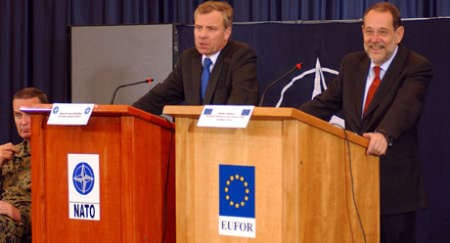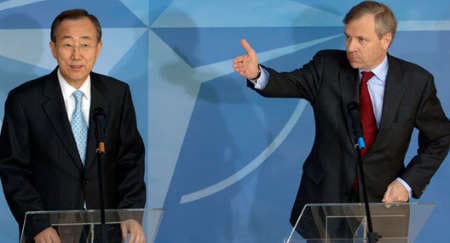David S. Yost explores how NATO could further combine its strengths with those of other international organizations.

December 2004, Bosnia and Herzegovina: NATO Secretary General, Jaap de Hoop Scheffer (left) and the European Union High Representative, Dr Javier Solana mark the end of NATO's SFOR Operation and the establishment of the EU "ALTHEA" Operation
(© NATO )
At the Riga Summit in November 2006, the NATO Allies endorsed a comprehensive civil-military approach to security. This approach marks another stage in a transition underway since the end of the Cold War. An essential part of this is improving the Alliance's cooperation with other international organizations.
NATO's transition in responsibilities and tasks since the early 1990s has led to extensive cooperation with the United Nations (UN), the European Union (EU), the Organization for Security and Cooperation in Europe (OSCE), and many other international organizations. While much has been achieved, various factors - including national and inter-institutional rivalries - have at times complicated the pursuit of better relations.
In addition, some states have retained a Cold War image of NATO as essentially a combat-oriented military organization. The attitude of "we do peace, NATO does war" also persists among some staff members of other international organizations. The fact that NATO has become the world's largest destroyer of small arms and light weapons is little-known outside the Alliance.
NATO is perhaps half-way through a transition from its Cold War posture to one adapted to current and emerging security requirements. It has had to grapple with both urgent crisis response and long-term stabilization and reconstruction tasks. It cannot effectively meet these challenges alone. NATO and other major international security organizations have to find ways to work together more productively if they intend to achieve their shared goals.
NATO in transition
Since the breakup of the former Yugoslavia began in 1991, the NATO Allies have had to deal with types of conflicts different from their Cold War preoccupation with deterring the outbreak of an alliance-versus-alliance conventional war that might escalate to nuclear war.
Since the early 1990s, the Allies have had to focus on the prevention and containment of ethnic and political conflicts within and between states. Allied goals have extended beyond stopping the immediate violence to creating the conditions necessary for an enduring resolution of the conflicts.
Since the terrorist attacks against the United States in September 2001, the Allies have become conscious of how failing states - such as Afghanistan under Taliban rule - can become havens for terrorist movements and organized criminal groups. To prevent new havens from being established, the Allies must achieve more than victory in the traditional sense of defeating an enemy's forces in combat.
The tasks of state-building and democratization cannot be accomplished with purely military means. Sustainable security requires stabilization, reconstruction, economic and social development, and good governance. Constructive intervention requires the contributions of multiple international organizations and non-governmental organizations (NGOs).
To prevent new terrorist and criminal havens from being established, the Allies must achieve more than victory in the traditional sense of defeating an enemy's forces in combat
In fact, the Alliance has been developing a "comprehensive approach" to deal with security challenges since the early 1990s. The Allies have previously used phrases such as 'Enhanced Civil-Military Cooperation', 'Concerted Planning and Action', and an 'Effects-Based Approach to Operations'. The comprehensive approach is similar to these concepts in calling for coordinated activity by multiple types of organizations in cooperation with local authorities to promote security and development.
The NATO Allies confirmed at the Riga Summit what they have recognized in practice since the early 1990s: other organizations have capabilities and mandates that NATO lacks to achieve the objectives it shares with its international partners. The three organizations with which NATO has worked most closely are the United Nations, the European Union, and the OSCE.
Diversity as a source of strength
The fact that international organizations have differing strengths and mandates has often helped in working out a sensible division of labour. NATO's most obvious comparative advantage is in its military capabilities, including its expertise in planning, organizing and conducting operations involving the armed forces of the Allies and security partners.
On some occasions the Allies have intervened decisively to separate warring parties and put an end to atrocities - as with, for example, Operation Deliberate Force in 1995 in Bosnia and Herzegovina and Operation Allied Force in 1999 in the Kosovo conflict.
The Allies have also played a leading role in providing security for the activities of other organizations. While not their sole raison d'être, this can be seen in the following NATO operations:
- the Implementation Force (IFOR) and Stabilization Force (SFOR) in Bosnia and Herzegovina from 1995 to 2004,
- the Kosovo Force (KFOR) since 1999, and
- the International Security Assistance Force (ISAF) in Afghanistan since 2003.
The Alliance has some non-military civil capabilities, notably in civil emergency planning, defence aspects of security sector reform, and partnership cooperation programmes. However, NATO is clearly incapable of undertaking the full range of tasks required for state-building and social and economic development.
The United Nations Security Council has a unique role in providing a framework of legitimacy for the use of force in situations other than the self-defence contingency covered by the UN Charter's Article 51 and the North Atlantic Treaty's Article 5. All the NATO Allies strongly prefer to conduct non-Article 5 operations with the legitimacy provided by a UN Security Council mandate.

January 2007, Belgium: Mr de Hoop Scheffer (right) welcomes United Nations Secretary General, Ban Ki-moon, to NATO Headquarters (© NATO )
Moreover, the Allies regard UN leadership in coordinating multilateral stabilization and reconstruction efforts as highly desirable, as with the UN Interim Administration Mission in Kosovo (UNMIK) and the UN Assistance Mission in Afghanistan (UNAMA). Some UN offices and agencies such as the Department of Peace Keeping Operations (DPKO), the UN Office on Drugs and Crime (UNODC), the UN Development Programme (UNDP), and the Office of Coordination of Humanitarian Affairs (OCHA) have capabilities unmatched by other organizations.
The UN also has an unparalleled ability to attract resources on a global basis.
The European Union has civilian assets that are outside NATO's scope of activity but that are essential to state capacity-building, including police, justice, and rule of law programmes.
The EU has financial resources and development means that can help in the economic recovery of war-torn societies. In some situations, the EU can offer an incentive to promote cooperation - the prospect of EU membership - that may be more potent than NATO's capacity to offer partnership or membership.
Under the NATO-EU "Berlin-Plus" arrangements completed in March 2003, NATO has twice provided assets and capabilities to support EU-led operations: Operation Concordia in the former Yugoslav Republic of Macedonia*, from March to December 2003, and Operation Althea in Bosnia and Herzegovina since December 2004. NATO and the EU have coordinated their efforts in support of the African Union in Darfur, UNMIK in Kosovo, UNAMA in Afghanistan, and elsewhere.
The OSCE's agenda has been for the most part distinct from (and complementary to) that of the Alliance. The OSCE concentrates on promoting:
- democratization,
- the rule of law,
- respect for human rights,
- reconciliation,
- conflict prevention, and
- post-conflict rehabilitation and peace-building.
In the political-military domain, the OSCE has provided a framework for arms control and has focused on confidence- and security-building measures, transparency measures, and "norm-setting". This last activity extends from implementing political and military codes of conduct to promoting respect for "best practices" guidelines in post-conflict rehabilitation processes. The Alliance has provided security for OSCE activities in territories where NATO forces have been deployed, and these activities have served NATO's broader political objectives in post-conflict situations.
NATO must work effectively with other organizations to establish the trust and confidence necessary for successful future operations. What some have called "ad-hoc-ery" in the coordination of efforts by international organizations since the early 1990s has worked, although at sub-optimal effectiveness. Some observers have accordingly referred to "an awkward teenage phase" in the Alliance's relations with other international organizations.
How can cooperation be improved?
Experts have advanced many suggestions for greater effectiveness in the conduct of operations. These include pre-operational planning conferences, discussions of lessons learned and enhanced public information policies.
Convening workshops might, for example, be a practical step, so representatives of the main international security organizations could discuss in an off-the-record fashion the principal obstacles to more effective cooperation and possible solutions.
Facilities such as the NATO Defense College in Rome and the NATO School in Oberammergau could also provide more extensive education and training opportunities for members of other international organizations and leading NGOs. Staff officer exchanges could promote networking and mutual understanding, and could build a stronger sense of pursuing shared objectives. The Alliance could also expand its exercise activities involving representatives of other international organizations as observers and participants.
Some observers have proposed creating an unclassified password-protected online central data base to avoid duplication in security and disposal activities for small arms, light weapons, ammunition and rocket fuel. Such a programme could also include border management, planning, exercises, and other activities. These arrangements could complement public diplomacy efforts and enable representatives of other international security organizations to gain a better understanding of NATO's capabilities and decision-making processes.
The more ambitious concepts include:
- convening NATO-EU-UN or NATO-EU-UN-OSCE meetings to discuss current operations;
- a multilateral standing staff of all major international security organizations;
- establishing a "contact group" of international organizations for each specific operation on the model of the Joint Coordination and Monitoring Board (JCMB) established for the implementation of the Afghanistan Compact; and
- a permanent assembly of international organizations and NGOs on the model of the Inter-Agency Standing Committee (IASC), which brings together the key UN and non-UN organizations involved in humanitarian assistance.
A standing assembly would allow NATO and its partners to deepen their expertise on operations from crisis-monitoring and prevention measures to possible intervention, if necessary, and stabilization and reconstruction. Conducting joint activities in a shared institution could also help organizations devise a common analytical framework and agree on a division of labour in future operations.
These bolder proposals suggest what the comprehensive approach might imply if it was pursued in a truly comprehensive way. However, certain states, within and outside NATO, as well as policy-makers in some organizations, might resist pursuing even the less ambitious concepts.
The tasks of state-building and democratization cannot be accomplished with purely military means.NATO is clearly incapable of undertaking the full range of tasks required for state-building and social and economic development
Some Allies have reservations about the Alliance assuming new political roles. They see formalizing and deepening the Alliance's relations with the UN, the OSCE, and other organizations as inconsistent with its traditional focus on collective defence and military operations.
Yet another obstacle is that international security organizations, despite their differing strengths and mandates, are to some extent in competition for resources and missions. Some are wary of arrangements that might somehow diminish their autonomy, authority, and status. The continuing competition also derives in part from the ambitions of some states for certain organizations.
Governments and international organizations have interests other than maximizing the effective use of resources and achieving optimal effects through cooperation. Practical "bottom-up" mission-driven cooperation between representatives of international organizations in the field has often proven more productive than "high politics" interactions among governments.
While a continued pattern of improvisation - ad hoc accommodations and compromises - appears likely, the construction of a more coherent architecture of international security organizations and NGOs is still a goal well worth pursuing.
